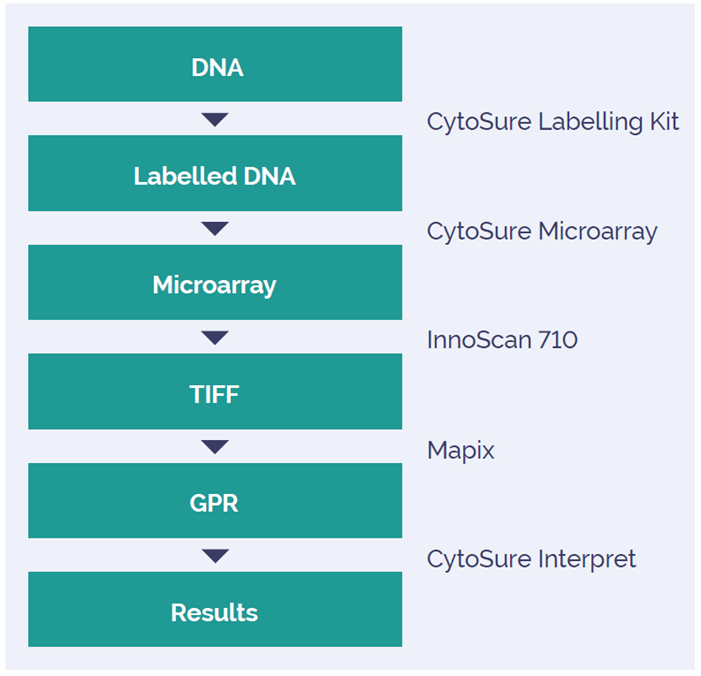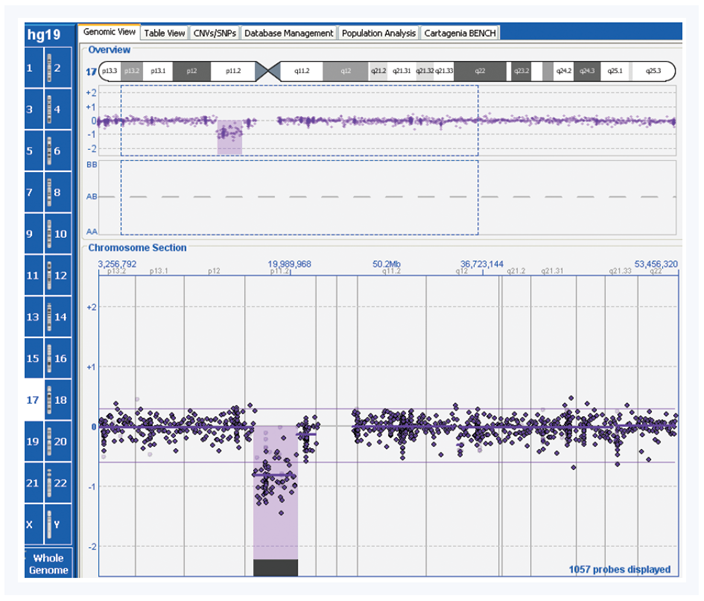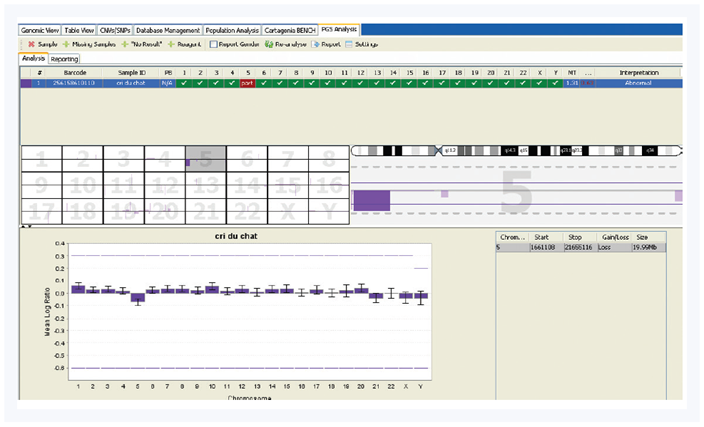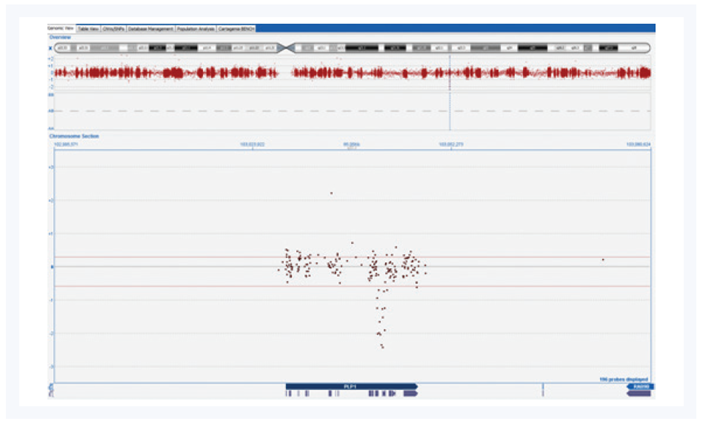Want to download this as a PDF? Download now
Adrianna Lagraulet (Innopsys)
OGT’s CytoSure® products provide researchers with the complete solution for highly accurate detection and interpretation of chromosomal abnormalities. They facilitate high-throughput analysis of the whole human genome to accurately identify the genetic variation underlying hundreds of genetic disorders and congenital syndromes that cause developmental delay. Critical to success, is the use a scanner which offers ease-of-use, high precision and reliability of results with a wide range of array formats and densities.
The InnoScan® 710 scanner from Innopys is a widely used, low cost, portable microarray scanner capable of scanning microarray slides with a resolution of 3 µm. It is the fastest scanner on the market with an adjustable reading speed from 10 to 35 lines per second. Offering reliable and traceable results, with a barcode reader, InnoScan 710 provides accurate control of acquired images and is supplied with a validation slide and associated Mapix® software that verifies scanner performance as well as offering a sophisticated feature extraction function.
With two high performance lasers with an excitation of 532nm and 635nm, the InnoScan 710 scanner complements OGT’s CytoSure range of microarray slides, reagents and analysis software. This application note illustrates the use of the InnoScan 710 scanner and Mapix with a range of OGT CytoSure cytogenetic array formats.
A range of OGT CytoSure slides, the CytoSure ISCA v2 (8x60k and 4x180k) arrays, the CytoSure Embryo Screen array (8x60k) and the CytoSure Medical Research Exome array (1x1M), were processed according to OGT protocols (www.ogt.com). Briefly, in the case of the CytoSure Embryo Screen Arrays, DNA was first amplified using the PicoPLEX™ kit (Rubicon). All other slides used 1µg of starting DNA. The DNA was then labelled using the CytoSure Genomic DNA Labelling Kit and purified with the supplied CytoSure columns. Sample DNA was labelled with Cy3 and Reference DNA with Cy5. After purification, the DNAs were pooled and dried in a SpeedVac™ until dry. The DNA was resuspended in water, CotI, 5x blocking agent (Agilent) and 2x High RPM hybridization buffer (Agilent) and hybridized to OGT’s microarray slides.
After hybridization, the slides were washed and scanned with the InnoScan 710 microarray scanner. Innopsys has developed an auto-setting function dedicated to oligo slides, either 8x60k or 4x180k. Using these slide configurations, all of the scan parameters are automatically adapted to slide format to get optimal signals in compliance with OGT’s QC metrics. The Oligo 8x60k and Oligo 4x180k scan configurations are available from Mapix version 7.4.0.
Following scanning, the image was feature extracted using the Mapix software. This was carried out by importing the GAL file supplied with the CytoSure array and feature extracting all the arrays on the slide simultaneously. The resulting .gpr files generated were then imported into CytoSure Interpret Software. Normalisation was carried out in the software using the Segmentation-based normalization. The process is summarized in Figure 1.
 Figure 1: Summary of the process used in this study.
Figure 1: Summary of the process used in this study.
The CytoSure ISCA v2 8x60k array comprises a research-validated collection of specific probes that enable reliable detection of copy number (CN) changes for a variety of genetic disorders. They offer excellent coverage with probes spaced throughout the genome and complete coverage, with increased probe density, in areas recommended by ClinGen (formerly the ISCA consortium). Thus ensuring uncompromising detection of CN changes in these cytogenetically important regions.
A CytoSure ISCA v2 8x60k slide was hybridized with DNA samples with a wide range of sized chromosomal gains and losses, ranging from large, such as NA00072 with a ~25Mb deletion, to small intragenic deletions. The results are shown in the Table below and in Figure 2.
 Table 1: Results from the CytoSure ISCA v2 8x60k array.
Table 1: Results from the CytoSure ISCA v2 8x60k array.
 Figure 2: Detection of a 3.6Mb deletion on chromosome 17 in sample NA18324.
Figure 2: Detection of a 3.6Mb deletion on chromosome 17 in sample NA18324.
The CytoSure 4x180k ISCA v2 array is similar to the 60k array in that it offers excellent coverage with probes spaced throughout the genome and complete coverage, with increased probe density, in areas recommended by ClinGen. The larger probe set of ~180k probes, offers superior CN resolution of 1 probe every 19kb in targeted regions and 1 probe every 25kb along the backbone, (compared to 1 probe every 40kb and 70kb, respectively, with the 8x60k array). The performance of the InnoScan710 when scanning CytoSure ISCA v2 4x180k slides was assessed. All arrays gave good or excellent DLRs (Table 2).
 Table 2: CytoSure ISCA v2 4x180k results, arrays have been scanned with an InnoScan 710 scanner and feature extracted using Mapix.
Table 2: CytoSure ISCA v2 4x180k results, arrays have been scanned with an InnoScan 710 scanner and feature extracted using Mapix.
The CytoSure Embryo Screen array utilizes long oligo array comparative genomic hybridization (aCGH) for superior aneuploidy and copy number detection. The array content has been optimized to work with small amounts of DNA amplified from a single cell, specifically single cells isolated from a pre-implantation embryo, following amplification by the Rubicon PicoPLEX kit. In this experiment 50pg of DNA was amplified using the PicoPLEX kit. The amplified DNA was then labelled and hybridized as detailed in the CytoSure Embryo Screen protocol. The slide was scanned using the InnoScan 710 scanner, feature extracted using Mapix and imported into CytoSure Interpret Software. Analysis was carried out using the PGS interpretation module and the results shown in Table 3 and Figure 3. All arrays gave good Signal to Noise Ratios (SNRs), while the DLRs were well below 1.0 which is classed as ‘excellent’ for PicoPLEX amplified material and is sufficient to detect aberrations of 15Mb and above.
 Table 3: CytoSure Embryo Screen Array results.
Table 3: CytoSure Embryo Screen Array results.
 Figure 3: Detection of a 15Mb deletion on chromosome 5 in sample NA14117, using a CytoSure Embryo Screen Array.
Figure 3: Detection of a 15Mb deletion on chromosome 5 in sample NA14117, using a CytoSure Embryo Screen Array.
The CytoSure Medical Research Exome array is a highly targeted exon-focussed array capable of detecting medically relevant microdeletions and microduplications. The array makes an ideal complement to an exome sequencing approach to provide a comprehensive mutation spectrum analysis in rare disease.
NA13434 DNA was labelled and hybridized to the array using the standard protocol and scanned using the InnoScan 710 scanner. Results are shown in Table 4 and Figure 4.
 Table 4: CytoSure Medical Research Exome array result.
Table 4: CytoSure Medical Research Exome array result.
 Figure 4: Detection of an aberration within the PLP1 gene using the CytoSure Medical Research Exome array scanned with the InnoScan 710 scanner.
Figure 4: Detection of an aberration within the PLP1 gene using the CytoSure Medical Research Exome array scanned with the InnoScan 710 scanner.
Conclusions
This application note illustrates how the InnoScan 710 scanner can be used effectively to scan a wide range of OGT’s CytoSure arrays to accurately detect chromosomal copy number variation. The Mapix software feature extracts the scanned image and can be coupled with the CytoSure Interpret Software to analyse the results in a fast, efficient process. It is recommended to use the oligo 8x60k or oligo 4x180k dedicated scanner auto settings, adapted to CytoSure 8x60k and 4x180k slides, respectively.
CytoSure®: For Research Use Only; Not for Diagnostic Procedures.
